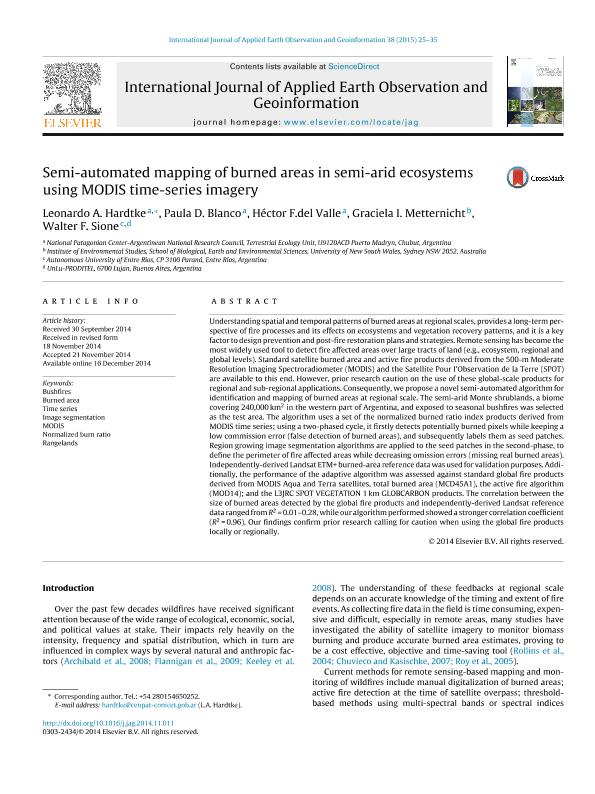Artículo
Semi-automated mapping of burned areas in semi-arid ecosystems using MODIS time-series imagery
Hardtke, Leonardo Andrés ; Blanco, Paula Daniela
; Blanco, Paula Daniela ; del Valle, Hector Francisco
; del Valle, Hector Francisco ; Metternicht, Graciela; Sione, Walter Fabian
; Metternicht, Graciela; Sione, Walter Fabian
 ; Blanco, Paula Daniela
; Blanco, Paula Daniela ; del Valle, Hector Francisco
; del Valle, Hector Francisco ; Metternicht, Graciela; Sione, Walter Fabian
; Metternicht, Graciela; Sione, Walter Fabian
Fecha de publicación:
12/2015
Editorial:
Elsevier Science
Revista:
Itc Journal
ISSN:
0303-2434
Idioma:
Inglés
Tipo de recurso:
Artículo publicado
Clasificación temática:
Resumen
Understanding spatial and temporal patterns of burned areas at regional scales, provides a long-term perspective of fire processes and its effects on ecosystems and vegetation recovery patterns, and it is a key factor to design prevention and post-fire restoration plans and strategies. Remote sensing has become the most widely used tool to detect fire affected areas over large tracts of land (e.g. ecosystem, regional and global levels). Standard satellite burned area and active fire products derived from the 500-m Moderate Resolution Imaging Spectroradiometer (MODIS) and the Satellite Pour l?Observationde la Terre (SPOT) are available to this end. However, prior research caution on the use of these global-scale products for regional and sub-regional applications. Consequently, we propose a novel semi-automated algorithm for identification and mapping of burned areas at regional scale. The semi-arid Monte shrublands, a biome covering 240,000 km² in the western part of Argentina, and exposed to seasonal bushfires was selected as the test area. The algorithm uses a set of the Normalized Burned Ratio Index products derived from MODIS time series; using a two-phased cycle, it firstly detects potentially burned pixels while keeping a low commission error (false detection of burned areas) , and subsequently labels them as seed patches. Region growing image segmentation algorithms are applied to the seed patches in the second-phase, to define the perimeter of fire affected areas while decreasing omission errors (missing real burned areas). Independently-derived Landsat ETM+ burned-areareference data was used for validation purposes. Additionally, the performance of the<br />adaptive algorithm was assessed against standard global fire products derived from MODIS Aqua and Terra satellites, total burned area ( MCD45A1) , the active fire algorithm ( MOD14) ; and the L3JRC SPOT VEGETATION 1km GLOBCARBON products. The correlation between the size of burned areas detected by the global fire products and independently-derived Landsat reference data ranged from R² = 0.01-0.28, while our algorithm performed showed a stronger correlation coefficient (R² =0.96) . Our findings confirm prior research calling for caution when using the global fire products locally or regionally.
Archivos asociados
Licencia
Identificadores
Colecciones
Articulos(IPEEC)
Articulos de INSTITUTO PATAGONICO PARA EL ESTUDIO DE LOS ECOSISTEMAS CONTINENTALES
Articulos de INSTITUTO PATAGONICO PARA EL ESTUDIO DE LOS ECOSISTEMAS CONTINENTALES
Citación
Hardtke, Leonardo Andrés; Blanco, Paula Daniela; del Valle, Hector Francisco; Metternicht, Graciela; Sione, Walter Fabian; Semi-automated mapping of burned areas in semi-arid ecosystems using MODIS time-series imagery; Elsevier Science; Itc Journal; 38; 12-2015; 25-35
Compartir
Altmétricas



